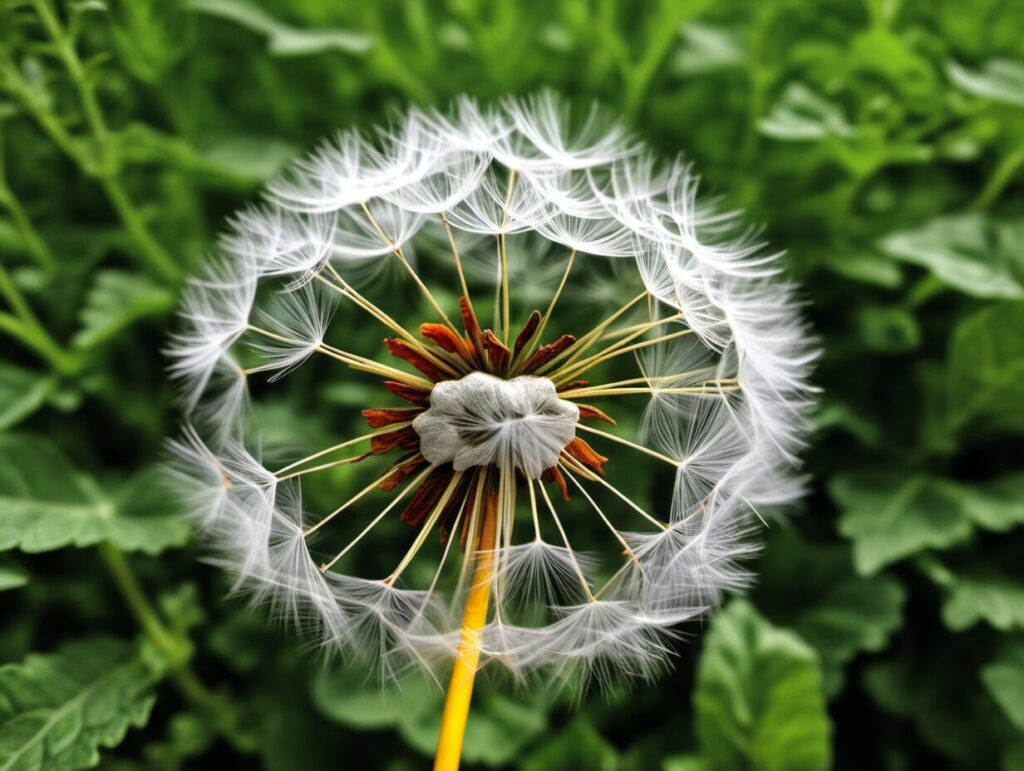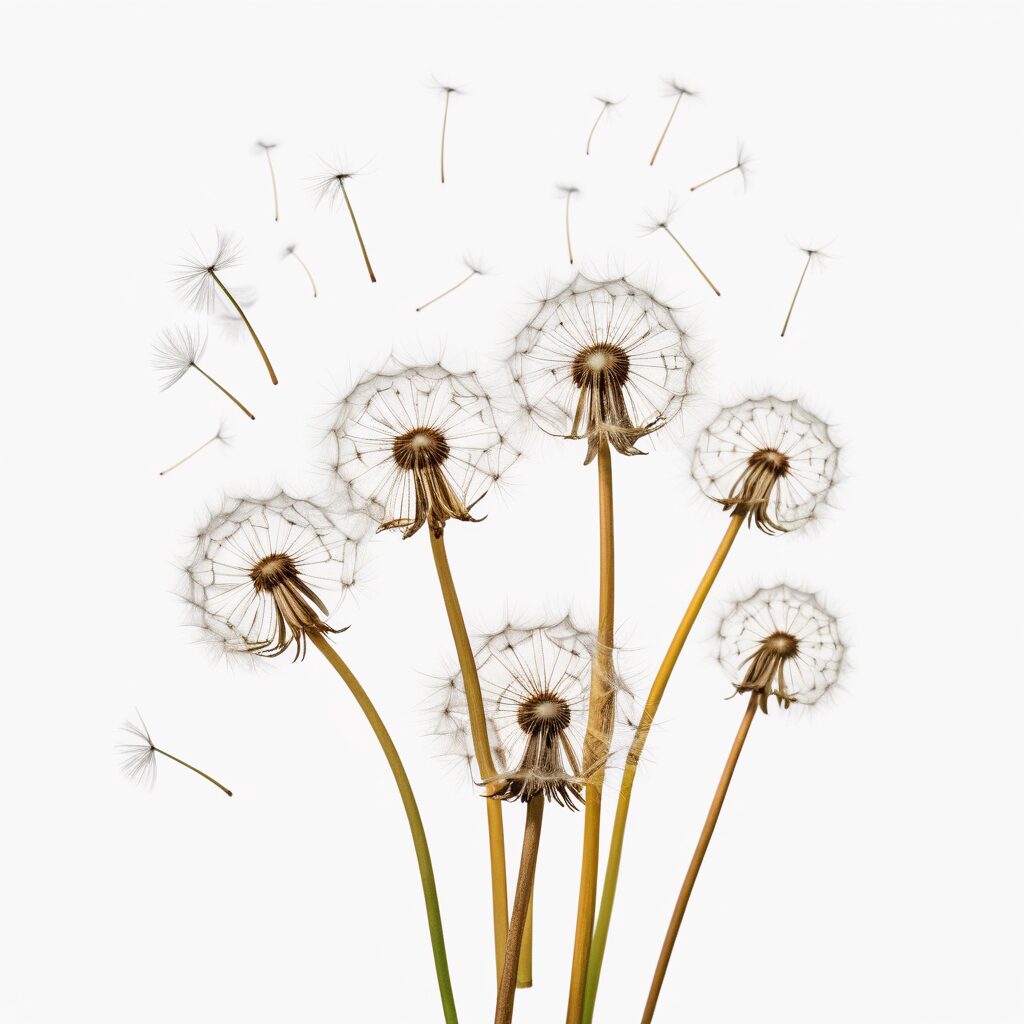Dandelions have long captured my imagination as symbols of resilience, creativity, and the quiet power of nature to renew and inspire. There is something undeniably poetic about these bright yellow flowers that push through cracks in the asphalt or spread wildly across untended fields. Each tiny seed, carried effortlessly on the breeze, seems to hold within it the dreams and wishes of future generations. I often find myself gazing up at a sky dotted with drifting dandelion puffs, marveling at their endless possibilities as I ponder how the life force energy of the world continuously shapes our existence. In those moments, when I look at the clouds and see their ever-changing forms, I can almost sense the creative spirit—the Mothers of All Life—quietly dreaming us into being, designing new forms with every passing moment. In the absence of a loved one whose presence once softened my soul, such as my dad lying in the grass beside me and watching the clouds go by, I find solace in carrying his memory forward in my tender dreams and in the living, breathing energy of nature.



The dandelion, with its vibrant yellow head that resembles the sun, its dispersing seeds that resemble twinkling stars, and the round puff ball evoking the gentle glow of the moon, encapsulates the journey of creation in one humble package. It is a pioneer plant—one of the first to colonize disturbed lands after a wildfire or a clearing—and this tenacity makes it a fitting metaphor for many of the challenges we face in life. Like the dandelion, my own ongoing project, Living Ground, has been about fighting through obstacles and persistently moving forward despite every setback. Even when team members have left or when progress seems imperceptibly slow, I draw strength from the way dandelions thrive under even the harshest conditions. They keep growing, keep regenerating, reminding me that our vision for a better future, for a community built on soil microbes, plants, and shared human values, is achievable with patience and unwavering commitment.
I have learned that creating a true sanctuary, whether in a garden or in life, is not about the perfection one sees at first glance. It is about the continuous effort—the careful tending of every seed, every cut of the soil, every moment spent nurturing even the humblest plant. The finished garden, with its cool shade and soft rustling leaves, is only the tip of the iceberg; beneath lies the truth of dirty hands and sweaty brows, of long days spent pouring love and energy into creating something greater than oneself. Not everyone understands that transformation takes time, and that a space must be cultivated with both resilience and tenderness. Dandelions, those uninvited yet wondrous “weeds,” embody that same spirit of persistence. They sprout and thrive in even the most inhospitable places, growing wild and free, refusing to be uprooted by the challenges that would defeat other plants. In this way, dandelions serve as a living metaphor for progress and hope—they are a reminder that from chaos and disruption, new beauty and possibility can always emerge.
In my garden, dandelions are much more than just a weed to be pulled out. I have come to cherish them as vital, nourishing allies that contribute to the overall health of the ecosystem. Their bright yellow flowers infuse the landscape with warmth and optimism, while their roots reach deep and anchor them firmly in the earth. Every part of the dandelion is useful—the leaves can be harvested young for use in salads, offering a slightly bitter but refreshing flavor that pairs well with sweeter greens; the roots, when roasted, provide a robust, earthy flavor that can be brewed into a natural coffee substitute; and even the delicate flowers impart a touch of wild sweetness when used in herbal teas. It is as if these tenacious plants hold the secrets of the earth, offering not only sustenance but also wisdom on how to reclaim vitality from even the most desolate settings.
I have often thought about how dandelions are referred to as “ruderal” plants—a term that comes from the Latin word rudus, meaning rubble. This terminology beautifully captures the essence of dandelions as the first green warriors to colonize disturbed or damaged soils. They are nature’s resilient architects, emerging first on freshly turned earth, on roadsides scarred by concrete and asphalt, and in gardens left bare after a storm. Their rapid growth, high fertility, and ability to disperse seeds widely mean they serve as living bridges between the past and the future, transforming barren spaces into thriving landscapes. In this way, dandelions echo the energy of new beginnings and the promise of regeneration, reminding me that every challenge is an invitation to grow and adapt.
I recall one particularly vivid afternoon in my childhood when the sun bathed our yard in a golden glow. I watched as my dad and I paused to admire a patch of dandelions emerging amidst the grass. My dad held up a single dandelion and explained, in his gentle, weathered voice, that dandelion seeds, when blown by the wind, could travel miles, seeking new places to grow. He described them as tiny adventurers, carrying whispers of hope and possibility wherever they landed. His words wrapped me in a sense of wonder and possibility, transforming what many might dismiss as a nuisance into a living symbol of life’s tenacity and promise. That day, I learned that even something as commonplace as a dandelion can hold profound meaning, and I have carried that lesson with me ever since.
Dandelions are also celebrated for their potent medicinal properties, a truth that ancient herbalists long understood. Often regarded as a humble weed by those who did not know any better, dandelion is, in fact, a powerhouse of nutrients and bioactive compounds. Its leaves, rich in vitamins A, C, and K, as well as minerals like calcium, iron, and potassium, are nature’s own multivitamin. These nutrient-dense greens support liver health and promote detoxification by acting as natural diuretics and blood purifiers. When dandelion leaves are consumed, their bitter taste stimulates digestion—a quality that has made dandelion a traditional remedy for digestive discomforts such as bloating and indigestion. The roots are equally remarkable; when roasted, they develop a deep, robust flavor that some liken to coffee, providing an energizing drink that is both earthy and unexpectedly satisfying. It is a reminder that what is often dismissed as a mere weed is, in truth, a versatile herb with a rich tapestry of uses.
There is an almost alchemical quality to dandelion that resonates deeply with me. In my quieter moments, I have watched the dandelion’s transformation from a bright yellow flower to a delicate puff ball whose seeds float gently in the air. Observing this metamorphosis, I am struck by the profound symbolism of letting go—the idea that each seed, as it drifts away on the wind, carries a part of our dreams and future aspirations. It is as if the dandelion is telling us to release what no longer serves us, to allow our burdens to disperse and to embrace change without fear. This imagery of dispersing seeds, shining like little stars against the vast sky, aligns perfectly with my vision for Living Ground—a project built on the principles of resilience, transformation, and the unyielding power of communal creation.
Dandelions have also enriched my understanding of the relationship between plants and the microbial world. Their presence in the garden fosters a complex, symbiotic relationship with soil microbes, particularly nitrogen-fixing bacteria such as Arthrobacter. These hardy microorganisms help break down organic matter, releasing nutrients that the dandelion’s deep tap root can then absorb. In turn, the dandelion exudes organic compounds through its roots that feed these helpful bacteria, creating a healthy, flourishing soil ecosystem. I’ve come to appreciate this remarkable interplay as a microcosm of the larger cycles in nature—a vivid demonstration of how even what we consider weeds play a vital role in sustaining life and enriching the soil with every tiny interaction.
In my own practice and in the gentle rhythm of my daily routines, dandelions have come to represent more than just a botanical curiosity. They embody the spirit of persistence and the beauty of transformation, a living metaphor for my journey with the Living Ground project. This project, which is still in its foundational stages as I work tirelessly to carve out resources and build a community that values sustainable, organic practices, mirrors the life cycle of the dandelion. Just as dandelions thrive in the face of adversity—pushing through asphalt, embracing harsh conditions, and dispersing seeds across miles—so too do the dreams and efforts that I invest in creating a more regenerative, inclusive future. The dandelion’s promise of renewal and growth, regardless of the circumstances, has been a source of constant inspiration for me. It reminds me not to seek perfection, but to celebrate progress and to recognize that every setback is simply an invitation to grow stronger.
For me, the beauty of dandelions lies not just in their vibrant appearance, but in the profound lessons they impart about resilience, transformation, and the value of releasing what no longer serves us. They teach me that nature works in cycles, that every end is the beginning of something new, and that our struggles and imperfections, much like the scattered seeds of the dandelion, are what ultimately give rise to new life and renewed hope. It is this deep connection with nature that has guided me on my path, inspiring me to nurture my garden not only as a means of sustenance but as a living sanctuary where dreams and memories intermingle.
I have experimented with dandelions in many ways over the years—incorporating their leaves into salads when young and tender, brewing dandelion tea to capture their bittersweet essence, and even roasting the roots to create a natural coffee substitute that carries the earthy flavor of the land. In my cozy Canadian cottage, I once blended roasted dandelion roots with chicory, a dash of fermented oats, and a touch of Chaga mushroom, creating an alternative “coffee” that warmed my spirit on cold mornings. With each sip, I felt as though I was sharing a secret with the earth—a delicate balance of robust flavors that spoke of transformation and renewal.
In my garden, I also intentionally plant dandelions, not to combat them, but to celebrate their wild, untamed spirit. I locate the sunniest spot in my yard where these rebels can stretch toward the light, loosening the soil with a gentle massage and welcoming them with a sprinkle of microbe-rich compost. I then scatter the seeds playfully, like confetti, watching them settle and grow in their own time. There is joy in not micromanaging nature; rather, it is about allowing dandelions to claim their own space, dancing freely and brightening the landscape with their bold yellow blooms. It is a reminder that while I strive to create order in my creative projects, I must also embrace the spontaneity and beauty of the unexpected.
Foraging for dandelions in the wild has its own quiet charm. I always ensure that the leaves I collect come from clean, pesticide-free environments, knowing that these wild herbs hold the power to gently boost our gut microbiome as well as provide an abundance of nutritional benefits. Rich in vitamins A, C, and K, and loaded with essential minerals such as calcium, iron, and potassium, dandelions are a veritable treasure trove of nourishment. Their bitter taste, which might be off-putting to some, is actually a gentle stimulant for digestion, urging the body to release its natural alkalinity and detoxify itself. In this way, the dandelion transcends its reputation as a mere weed to become a healing companion—a piece of living medicine that carries the combined energy of resilience, regeneration, and vitality.
With so many gifts to offer, dandelions have reshaped my perception of what it means to nurture oneself and one’s surroundings. They remind me that even the most common, often-dismissed plants hold within them the potential to enrich our lives in diverse ways—from the comforting taste in our salads and teas to the deep, healing properties in their roots and leaves. They are nature’s stubborn survivors, thriving even in the most neglected corners of our world, and in doing so, they teach us that our own imperfections and setbacks are not failures, but rather invitations to grow and evolve. They compel us to embrace our journey with open hearts and to trust in the process, no matter how winding or challenging it may be.
In the grand scheme of life, as I shepherd my own dreams and the ambitious Living Ground project forward, the dandelion is both a muse and a mentor. Through its resilient growth and undaunted spread, it whispers to me that every setback is temporary, every broken path is merely the prelude to something beautiful and unexpected. It stands as a potent reminder that even as we face the brute forces of the world—whether the harsh concrete of urban jungles or the unpredictable tides of fate—we can still thrive, spread our seeds, and illuminate the dark spaces with our own unique light.
Now, in tribute to this remarkable herb and the way it continuously inspires me to see the beauty amid adversity, I’d like to share one special recipe—a Dandelion Coffee Substitute. This beverage, crafted from roasted dandelion roots, captures the earthy, robust essence of the wild dandelion while providing a warm, invigorating start to the day. Begin by harvesting fresh dandelion roots from a clean, pesticide-free area. Rinse thoroughly to remove any soil, then chop into small pieces. Spread the chopped roots evenly onto a baking sheet and roast in an oven preheated to 350°F (175°C) for about 30 to 40 minutes, stirring occasionally, until the roots turn a deep, rich brown and develop a slightly bitter aroma comparable to that of coffee. Once roasted, allow the roots to cool completely, then grind them in a coffee grinder until a coarse powder forms. To prepare a cup of the coffee substitute, boil water and add 1 to 2 teaspoons of the dandelion root powder per 8-ounce cup. Let the mixture steep for about 5 to 10 minutes, then strain if desired and serve hot. Enjoy this brew as a caffeine-free alternative to coffee, savoring its full-bodied, earthy flavor that speaks of nature’s resilience and the endless cycle of renewal.
Dandelions, with all their defiant beauty and unexpected generosity, have taught me that every obstacle holds a seed of potential, and every day provides a new beginning. Their journey from unassuming weeds to essential symbols of transformation echoes the very essence of our own creative and regenerative processes. As I move forward—nurturing my garden, my projects, and the dreams they inspire—I carry with me the timeless lessons of the dandelion: to be resilient, to embrace the unplanned, and to trust that even the simplest things can bring forth profound healing and boundless hope.




